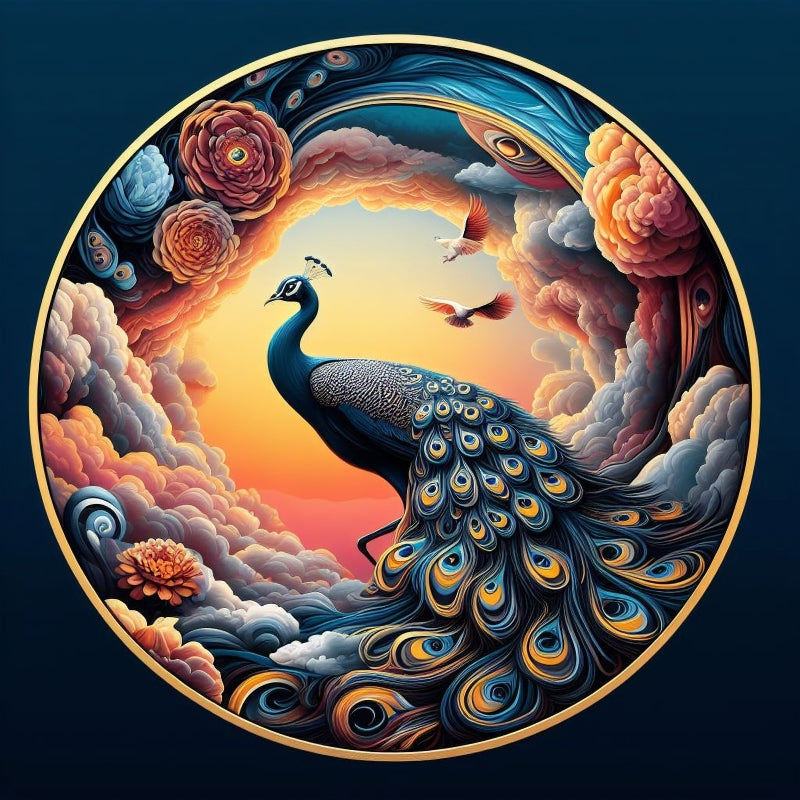
Why the Peacock is the National Bird of India
Share
The Indian peacock, scientifically known as Pavo cristatus, is not just a bird; it is a vibrant symbol of India's rich cultural heritage and natural beauty. Declared the national bird of India in 1963, the peacock embodies the country's diverse traditions, artistic expressions, and ecological significance. This blog post delves into the reasons behind the peacock's designation as the national bird, exploring its characteristics, cultural importance, and conservation status.
- Unique Characteristics of the Peacock
The Indian peacock is renowned for its stunning appearance. Here are some key features that make it stand out:
- Vibrant Plumage: Male peacocks are famous for their iridescent feathers, which display a dazzling array of colors, including blue, green, and bronze. The long tail feathers, or train, can reach lengths of up to 1.5 meters (approximately 5 feet) and are adorned with eye-like patterns known as ocelli. These feathers are not only beautiful but also play a crucial role in courtship displays.
- Courtship Display: During mating season, male peacocks perform elaborate courtship dances to attract females. This display involves fanning out their tail feathers and shaking them to create a mesmerizing spectacle. The vibrancy and symmetry of their plumage are believed to signal health and genetic fitness to potential mates.
- Size and Weight: Adult male peafowl can weigh between 4 to 6 kg (approximately 8.8 to 13.2 lbs), while females are slightly smaller and less colorful. The female peafowl, known as a peahen, has brownish plumage that provides camouflage while nesting.
- Cultural Significance in India
The peacock holds immense cultural importance in India, deeply embedded in various traditions, religions, and art forms:
- Religious Symbolism: In Hindu mythology, the peacock is associated with several deities. It is considered the vehicle (vahana) of Lord Murugan, the god of war and victory. The bird symbolizes grace and beauty in Hindu texts and is often depicted alongside goddesses such as Saraswati and Lakshmi.
- Art and Literature: The peacock has inspired countless works of art, poetry, and literature throughout Indian history. Its image is prevalent in traditional paintings, sculptures, textiles, and dance forms like Bharatanatyam. The bird's beauty has made it a favorite subject among artists who seek to capture its elegance.
- National Identity: As the national bird of India, the peacock represents the country's natural heritage and biodiversity. It serves as a reminder of India's commitment to preserving its wildlife and promoting ecological awareness.
- Ecological Role
The Indian peacock plays a vital role in its ecosystem:
- Omnivorous Diet: Peafowls are omnivorous birds that feed on a variety of foods including seeds, fruits, insects, small mammals, and reptiles. Their feeding habits help control insect populations while contributing to seed dispersal within their habitats.
- Habitat Preferences: Peafowls thrive in diverse environments ranging from forests to agricultural fields and urban areas. They prefer open woodlands with nearby water sources where they can forage for food while maintaining safety from predators.
- Conservation Status
While the Indian peacock is currently classified as "Least Concern" by the International Union for Conservation of Nature (IUCN), it faces several threats that could impact its populations:
- Habitat Loss: Urbanization and agricultural expansion have led to significant habitat destruction for many wildlife species, including peafowls. As forests are cleared for development or agriculture, these birds lose their natural habitats.
- Human-Wildlife Conflict: As human populations encroach upon their habitats; conflicts arise when peafowls raid crops or gardens in search of food. This can lead to retaliatory actions against these birds by farmers seeking to protect their livelihoods.
- Legal Protection
Recognizing the cultural significance of the Indian peacock and its role in maintaining biodiversity, it is protected under the Indian Wildlife (Protection) Act of 1972. This legislation prohibits hunting or harming these birds and promotes conservation efforts aimed at preserving their populations.
- Peacocks in Modern Culture
In contemporary India, the peacock continues to be celebrated as a symbol of beauty and grace:
- Festivals: The peacock is often featured in various cultural festivals across India. During celebrations such as Teej or Raksha Bandhan, images or motifs of peacocks are used decoratively to symbolize joy and festivity.
- Tourism: Peafowls attract tourists to national parks and wildlife sanctuaries where they can be observed in their natural habitats. Birdwatching tours often highlight these magnificent creatures as part of India's rich wildlife offerings.
- Educational Importance
The Indian peacock serves an educational purpose beyond its aesthetic appeal:
- Wildlife Education: Schools and educational programs use the peacock as a focal point for teaching students about biodiversity conservation and environmental stewardship . By learning about this national symbol, students gain an appreciation for wildlife protection efforts.
- Cultural Awareness: Understanding the significance of the peacock helps foster respect for India's diverse cultural heritage while promoting awareness about traditional practices that honor nature.
Conclusion
The Indian peacock's designation as the national bird of India reflects its unique characteristics, cultural significance, ecological role, and legal protections aimed at ensuring its survival. With its vibrant plumage and graceful movements, this magnificent bird embodies the essence of India's rich biodiversity. As we celebrate this national symbol—let us also commit ourselves to protecting its habitats from threats posed by urbanization or climate change while fostering coexistence strategies that benefit both humans and wildlife alike.
In recognizing why the Indian peacock holds such an esteemed place within our hearts—may we continue to appreciate not only its beauty but also our responsibility toward conserving nature for future generations!
Citations:
[1] https://www.cheggindia.com/general-knowledge/national-bird-of-india/
[2] https://knowindia.india.gov.in/national-identity-elements/national-bird.php
[3] https://seaworld.org/animals/facts/birds/indian-peafowl/
[4] https://www.youtube.com/watch?v=y1zLPfhorfo
[5] https://www.indembhelsinki.gov.in/national-bird.php